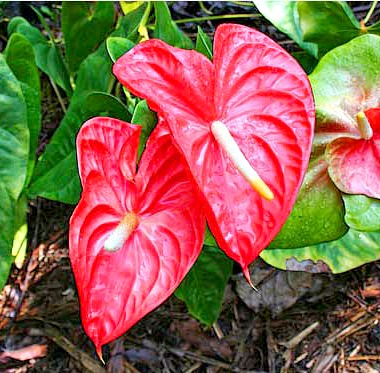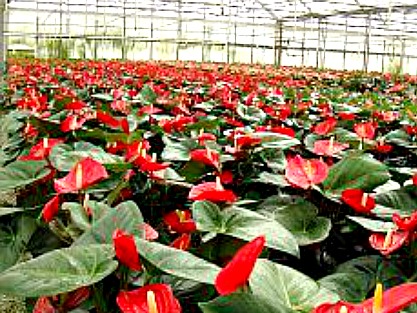 Anthurium (Anthurium andreanum Lind.) is a large genus species, belongs to the family Araceae. Anthurium can also be called “Flamingo Flower” or “Boy Flower”, both referring to the structure of the spathe and spadix. There are two types of anthurium under cultivation: the foliage and the flowering types. The foliage is grown for their velvety leaves while the flowering type is for their showy flowers, which consists of spadix and spathe. The true flowers are borne on a spike called spadix protruding from the base of the spathe. The spathe is a modified leaf typically heart shape. It comes in different colors – pink, white, green white and red.
Anthurium (Anthurium andreanum Lind.) is a large genus species, belongs to the family Araceae. Anthurium can also be called “Flamingo Flower” or “Boy Flower”, both referring to the structure of the spathe and spadix. There are two types of anthurium under cultivation: the foliage and the flowering types. The foliage is grown for their velvety leaves while the flowering type is for their showy flowers, which consists of spadix and spathe. The true flowers are borne on a spike called spadix protruding from the base of the spathe. The spathe is a modified leaf typically heart shape. It comes in different colors – pink, white, green white and red.
Recommended Varieties:
- Nitta (orange)
- Kaumana (red)
- Ozaki (dark pink)
- Kaonaiwan (white)
- Pink Exotica (light pink)
- Margaretha (white)
- Midori (green)
- Mauricia (dark pink)
- Claudia (red)
- Leigh (beige)
How to grow Anthurium
ENVIRONMENTS
Anthuriums grows in a high organic, well aerated medium with good water retention capability, but also good drainage. A good medium is one that is able to anchor the roots and stem so that the plant will not topple over as it grows upwards yet provide sufficient moisture, nutrients and aeration to the plant.
The following criteria must be considered in the selection of media: availability, cost, handling ease, aeration and drainage.
Various combination of soil, farmyard manure, sugarcane bagasse, cane ash are commonly used in commercial cultivation. Small producers use a variety of materials, namely wood shavings, saw dust, leaf pruning, wood charcoal and farmyard manure. Sugarcane straw or bagasse is being used as mulch also.
SPACING
The present trend for maximum production is to practice closer planting with heavy pruning. These closer, 30cm x 30 cm planting provide approximately 62, 500 plants per hectare(2.5 acre). Since dense planting prevent good air circulation and hinder spray penetration, rigid leaf pruning and spraying must be followed to keep disease and insect damage at a minimum. An anthurium plant may be pruned to a minimum of four leaves without and adverse effect on flower production and quality. Planting distance varies with the vigor of the cultivar, the type of shade and the planting rotation observed.
TEMPERATURE
Anthurium thrives when the temperature ranges between 18 C – 27 degrees centigrade.
LIGHT
Shade is necessary for normal growth of anthurium. The degrees of shading varies with the cultivar, the age of the plant and the climate under which it is grown. The shade requirements usually range from 60-80% of full sunlight. Insufficient shading often results in damage to leaves and eventually death of the plant. Shaded cloth housed have the following advantages: they provide uniform shade, plants may be planted immediately after construction, reduce bird and insect damage to minimum, provide maximum freedom of work space and produce more flowers per unit area.
HUMIDITY
The best relative humidity is 70-80%.
FERTILIZERS
250kgs of triple super phosphate per hectare are mixed with the growing medium prior to planting i.e. 4gram per plant. After 15 days of planting about 4 g of 13:13:20:2 per plant per month. Care must be taken to water the plants after application of fertilizer because the fertilizer has the tendency to burn the foliage. The pelletized and slow release forms are less damaging and are more often used. Many growers use organic fertilizers such as farmyard manure with about 2 g of 13:13:20:2 per plant per month. Foliar fertilizer may be applied monthly.
HARVESTING
Anthurium blooms are usually harvested once a week. The maturity of the flowers for harvesting is determining by the firmness of the peduncle and the degree of color change of the spadix.
The flowers mature on the spadix from the base towards the apex. As they mature a change of color can be observed that moves from the base to the tip of the spadix within a period of 3-4 weeks. After the lower quarter of the spadix has changed color, the anthurium is referred to as one quarter mature. Most anthurium blooms are harvested at about three quarters maturity because it is believed that at the time they have the longest shelf-life as cut flowers.
Sources: wikipedia.org, orchidsasia.com; Photos: orchidsasia.com
